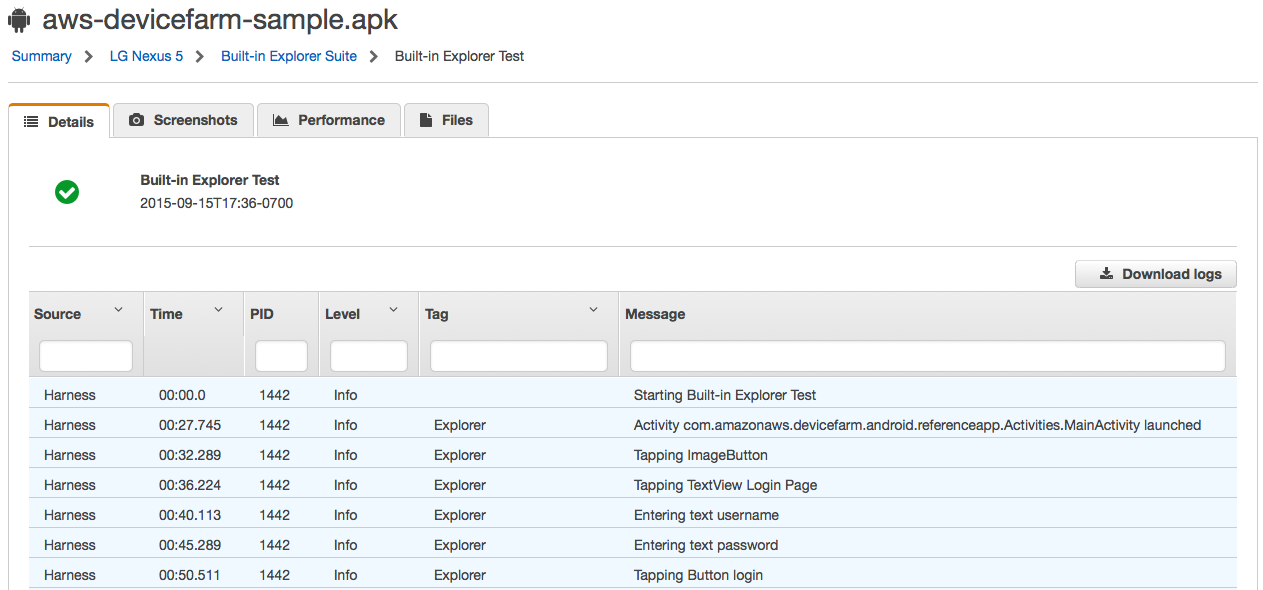Front-End Web & Mobile
Test user flows through your Android app with AWS Device Farm’s built-in app explorer. No scripts required.
Starting today, you can view details about how your Android app performs on real devices in the AWS Cloud without writing your own test scripts. AWS Device Farm’s new Built-in: Explorer test deploys an app explorer that crawls your application, analyzes each view it encounters, and interacts with each view’s controls as an end user would. The app explorer captures screenshots, logs, and performance data as it explores your app. All results and artifacts are collated into a Device Farm report and also made available through the API.
The app explorer works with both native and web controls, and will tap buttons, insert placeholder text into text inputs, and open and interact with menus. It captures a screenshot and logs each interaction that was performed. In addition, if your app requires an account login, you can provide credentials that the app explorer will use if it finds the login form.
Getting started
1. First, login to the AWS Device Farm console. If you’re new to Device Farm, don’t worry. You can get started with a one-time free trial of 250 minutes.
2. From within the Device Farm console, go to a Device Farm project and start the “Create a new run” wizard by clicking the “Create a new run” button. If it’s a brand new project, the wizard will start automatically.
3. Next, upload your Android app (.apk).
4. On the Configure Test step, select “Built-in: Explorer” from the test types. If you have a login form within your app, you can use the username and password fields to specify the credentials the app explorer should use.
5. Click “Next” until you’re on the Review and Start Run step. If everything looks okay, click “Confirm and start run.”
Analyzing results
As each device completes its Built-In: Explorer test, the results will be pulled into the report. You can view all screenshots in a single place on the report’s summary view by clicking on the “Screenshots” tab. You can also drill down to a specific device by clicking on the desired device from the report summary view in the “Devices” section.

View logs, screenshots, and performance data for a specific device by selecting it from the report summary view
From within the device view, you can analyze logs, performance data, and screenshots collected by the app explorer for the specified device.

Viewing logs captured by the app explorer on a specific device
Conclusion
The app explorer enables you to test basic user flows through your Android application without writing test scripts, allowing you to get started with automated testing faster and test more often during development. In addition to starting the Built-in: Explorer test from the console and SDKs, you can automatically kick off app explorer tests in your Jenkins continuous integration environment with the Device Farm Jenkins plugin.
You can also augment the app explorer with your own custom tests, which allow you to exercise specific functionality within your app and take screenshots exactly where you want. Custom tests are complimentary to the app explorer, which crawls your app without consideration for your app’s business logic. You can write custom tests in a number of frameworks like Espresso, Calabash, and Appium. Learn about supported framworks in the Device Farm documentation and get started quickly using the Device Farm Android app and sample scripts.
Please let us know if you have feedback or questions about the app explorer or AWS Device Farm in general in the comments or in the developer forum.